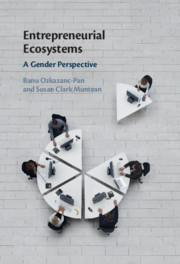Book contents
- Entrepreneurial Ecosystems
- Entrepreneurial Ecosystems
- Copyright page
- Contents
- Tables
- Preface
- 1 Introduction
- 2 Entrepreneurial Ecosystems
- 3 Understanding Gender and Inclusion in Entrepreneurial Ecosystems
- 4 Individual-Level Dynamics
- 5 Organizational-Level Dynamics
- 6 Gendering Institutions and Institutional Analysis
- 7 Intersectional Analysis
- 8 Holistic Solutions for Inclusive Economic Development through Entrepreneurship
- Index
- References
3 - Understanding Gender and Inclusion in Entrepreneurial Ecosystems
Published online by Cambridge University Press: 20 October 2021
- Entrepreneurial Ecosystems
- Entrepreneurial Ecosystems
- Copyright page
- Contents
- Tables
- Preface
- 1 Introduction
- 2 Entrepreneurial Ecosystems
- 3 Understanding Gender and Inclusion in Entrepreneurial Ecosystems
- 4 Individual-Level Dynamics
- 5 Organizational-Level Dynamics
- 6 Gendering Institutions and Institutional Analysis
- 7 Intersectional Analysis
- 8 Holistic Solutions for Inclusive Economic Development through Entrepreneurship
- Index
- References
Summary
The third chapter focuses explicitly on the relevance of gender for entrepreneurial ecosystems. The chapter first discusses the differences between sex, gender, and gender relations to lay the foundation for a dynamic understanding of actors and entrepreneurial ecosystems. Guided by feminist perspectives in entrepreneurship and sociology the chapter provides theoretical insights, derived from the various ways in which gender is studied, on how gender can be conceptualized and how inclusion is a multifaceted concept and practice. The chapter then offers a guiding definition of gender inclusion in relation to entrepreneurial ecosystems and moves on to provide insights about how to study it in relation to individuals, organizations, and sociocultural norms at the same time. In doing so, this chapter provides a multifactor and multilevel gender framework for understanding economic inclusion in relation to entrepreneurial ecosystems.
- Type
- Chapter
- Information
- Entrepreneurial EcosystemsA Gender Perspective, pp. 62 - 97Publisher: Cambridge University PressPrint publication year: 2021



